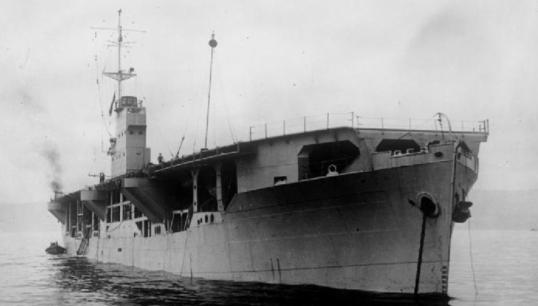Rapana

The build
Built at the Wilton-Fijenoord yard in Schiedam, Rapana came into service in May 1935. The vessel was initially operated for the Shell subsidiary NV Maatschappij La Corona, and ran between Europe and Curaçao and in the Mediterranean until it was switched to the Anglo-Saxon Petroleum Company's fleet in 1938.
Requisitioned
Soon after the outbreak of war in 1939, Rapana was requisitioned for service as an oiler and sailed from Liverpool on its first Atlantic convoy at the end of September. Over the next three and a half years, it took part in further convoys in the Mediterranean and to destinations such as Bermuda, Curaçao, Aruba, Trinidad, Guantanamo, Key West, Halifax, and New York.
In October 1942, faced with mounting merchant ship losses in the Atlantic, the Admiralty decided that nine Rapana-class tankers should be converted into MACs to provide increased air protection to convoys in the middle of the ocean.
Aircraft carrier
Rapana became the first ship to serve in the new role, emerging from the Smith's Dock Company yard in North Shields in July 1943 after six months of work. The superstructure was replaced by a flight deck, and small bridge island was fitted on the starboard side, along with arrester gear, a safety barrier, and additional generators to provide the power for extra radar and communications equipment.
Rapana carried four Fairey Swordfish aircraft on the flight deck and continued to transport crude oil cargoes. By the end of the war, the ship had taken part in a further 14 Atlantic convoys – mainly between Liverpool and New York – even though the MACs had been originally planned as a temporary measure until more effective convoy protection could be put in place.
Reconverted
At the end of the war, Rapana was reconverted into a tanker and returned to Shell's UK fleet, mainly running once again between Europe and Curaçao. In 1950 the ship was transferred back to La Corona and renamed Rotula. After a further seven years of commercial service, the vessel was laid up at the end of 1957 and sold for scrapping in Japan in January 1958.
Rapana Fact File
Who built Rapana?
Rapana was built by Maatschappij Wilton-Fijenoord
How powerful was Rapana?
Rapana had an eight-cylinder engine developing 3,500bhp
How long was Rapana?
Rapana was 146.61m (480ft) in length
Contribute
Are you knowledgeable about this vessel?
Submit your contribution to this article to our editorial team.
Write to usView more ships of the past
HMS Beagle
Launched 200 years ago, HMS Beagle has been described as one of the most important ships in history – thanks to the observations on evolution and natural selection that its famous passenger Charles Darwin made during a five-year voyage around the world between 1831 and 1836.
Common.ReadMoreHMS Beagle
Oxfordshire
The Oxfordshire had a 34-year long career as an emigrant ship, passenger liner and cruiseship.
Common.ReadMoreOxfordshire
Ruahine
Entering into service just over 70 years ago, the Ruahine was the last passenger-carrying ship built for the New Zealand Shipping Company (NZSC), and the third to bear the name – which means 'wise woman' in Māori.
Common.ReadMore